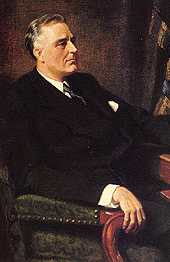 |
|
|
History
of the United States > The Great Depression and the New Deal |
|
In October 1929 the stock market crashed, wiping out 40 percent of the paper values of common stock and triggering a worldwide depression. By 1933 the value of stock on the New York Stock Exchange was less than a fifth of what it had been in 1929. Business houses closed their doors, factories shut down and banks failed. Farm income fell some 50 percent. By 1932 approximately one out of every four Americans was unemployed. The core of the problem was the immense disparity between the country's productive capacity and the ability of people to consume. Great innovations in productive techniques during and after the war raised the output of industry beyond the purchasing capacity of U.S. farmers and wage earners. The presidential campaign of 1932 was chiefly a debate over the causes and possible remedies of the Great Depression. The Republican Herbert Hoover planned to depend largely on natural processes of recovery, while the Democrat Franklin D. Roosevelt was prepared to use the federal government's authority for bold experimental remedies. Roosevelt was elected president on the platform of a "New Deal" for the American people. In a certain sense, it is fair to say that the New Deal merely introduced types of social and economic reform familiar to many Europeans for more than a generation. What was truly novel about the New Deal, however, was the speed with which it accomplished what previously had taken generations. Within three months, Roosevelt enacted a number of laws to help the economy recover. New jobs were created by undertaking the construction of roads, bridges, airports, parks and public buildings. The Agricultural Adjustment Act (AAA) passed by Congress in 1933 to provide economic relief to farmers, helped increase farm income. But throughout the 1930s, and in particularly from 1935 to 1938, a severe drought hit the Great Plains states and violent wind and dust storms ravaged the plains in what became known as the "Dust Bowl." The New Deal sponsored a remarkable series of legislative initiatives and achieved significant increases in production and prices -- but it did not bring an end to the Depression. In the face of pressures from left and right, President Roosevelt backed a new set of economic and social measures (Second New Deal), among them measures to fight poverty, to counter unemployment with work and to provide a social safety net. The Works Progress Administration (WPA), the principal relief agency of the so-called second New Deal, was an attempt to provide work rather than welfare. Buildings, roads, airports and schools were constructed. Actors, painters, musicians and writers were employed through the Federal Theater Project, the Federal Art Project and the Federal Writers Project. But the New Deal's cornerstone was the Social Security Act of 1935. It created a system of insurance for the aged, unemployed and disabled based on employer and employee contributions. In 1936, Roosevelt won an even more decisive victory than in 1932. |
||
| Texts
are abridged from U.S. State Department IIP
publications and other U.S. government materials. |
||
|
What
kind of information materials are available?
CD: These documents are available in fulltext format on the About the USA CD-ROM. Teachers: Request a copy for classroom use. L: Selected documents are available in German as well as other languages, including Arabic, Chinese, French, Spanish, Persian and Turkish. |
DISCLAIMER
Any reference obtained from this server to a specific commercial product, process, or service does not constitute or imply an endorsement by the United States Government of the product, process, or service, or its producer or provider. The views and opinions expressed in any referenced document do not necessarily state or reflect those of the United States Government. |
 U.S. Diplomatic Mission to Germany /Public Affairs/ Information Resource Centers Updated: April 2008 |
